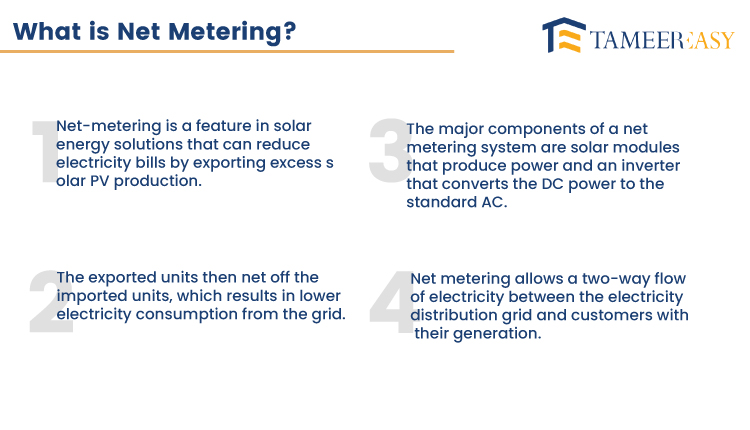Have you heard that the Water and Power Development Authority (Wapda) will pay you instead of sending you an electricity bill? Though it may not have always been the case, net metering is today more typical than ever. The reason for this is that everyone is turning towards solar systems.
In a solar system, you feed back any excess energy produced by your load into the WAPDA grid, and then you reconcile your accounts with WAPDA and get paid. However, solar system intsallation has its challenges.
Net metering is used throughout the entire procedure. This article will answer all your net metering questions and even walk you through the complete net metering reading procedure.

What is Net Metering?
When solar system owners with solar panels installed at their homes produce more electricity than they need, they can send the extra back to the grid through a billing system called net metering. They get credits for the extra electricity sent to the system through net metering.
Net Metering Installation Procedure
Regarding the installation, numerous distribution businesses (Discos) are functioning in Pakistan in diverse areas. IESCO serves Islamabad, LESCO serves Lahore, and MEPCO serves Multan. When you install a three-phase metre, these distribution firms allow net metering.
The approved load, as indicated on the metre, determines approval. According to regulations, you can apply for up to 1.5 times the allowed load for net metering approval. A generation licence for it is also available. For instance, if you have a 10 kW system, net metering approval for 15 kW is possible.
Additionally, the suppliers you used to buy and install the system, or those in charge of checking and commissioning it, must be AEDB (Alternative Energy Development Board) authorised vendors.
Benefits of Net Metering/Solar System
The first factor is how much the system you install costs and the existing tariffs. Normally, you get the system’s return investment in three to four years. The inverter lasts longer than five years, while the panels have a lifespan of 25 years.
You use all the energy produced or used in your home during this time while exporting any extra units back to the grid. After three to four years, you can use electricity provided without charge.
Second, the entire neighbourhood gains from this jointly. Solar energy is a green energy source obtained from the sun, a natural resource. It has no pollutants or carbon emissions, which is advantageous for the environment. The benefits of solar energy spread throughout society, the community, and the world as more people use it.
Challenges Faced During Net Metering Installation
- It’s simple to do this; all you must do is follow the steps. And the prerequisites—come first in procedures.
- For instance, you need a load of at least 10 kW to qualify for net metering on a 15 kW system. You must upgrade your permitted load to 10 kW if it is currently 5 kW.
- The same goes for your three-phase metre. You must upgrade your single-phase metre to three-phase if you currently have one.
- The Alternative Energy Development Board (AEDB) must have given your vendor its approval seal.
These are some of the important aspects to keep in mind. Once you have finished your prerequisites, there are no more difficulties.


Right Time for Net Metering Installation
You can do it before installing solar panels, without a doubt. You can do that in advance, thanks to net metering regulations. After that, you must install the system within six months of receiving the licence.
Application Procedure for Net Metering
To begin with, you must meet these prerequisites:
- You should process your application using an AEDB-approved vendor.
- There are currently two options. You don’t need to go to NEPRA if the load is less than 25 kW because that distribution company’s load sanctioning authority (LESCO, FEACO, etc.) will handle that.
- However, if it is greater than 25 kW, you must visit the Mirad office, where your case will be handled.
- After that, a reference number is given to you. There, they gather the file and all the supporting documentation and process it for the NEPRA generating licence.
- ID cards, a three-phase connection bill, property verification of the installation site, a single-line diagram, and data sheets are required.
- An AEDB-approved vendor generally prepares these documents and takes care of all the other elements on your checklist by gathering and approving them.
Operating Net Metering and Checking Bidirectional Meter Reading
- First, remember that parameters are written in electricity metres when calculating numbers. Thus, the units—which we refer to as kWh—are written or shown next to them.
- Since it uses net metering, it contains two different types of units: those used for ordinary billing and those used to track different types of consumption. Both peak and off-peak times are taken into account.
- When net metering is active, the grid, our distribution business, sends us devices that track peak and off-peak hours.
- The additional units are those that we export. The grid receives energy from our solar system, and these units are also determined by peak hours and off-peak hours.
- Two parameters are available for this. One is used to track units imported during peak and off-peak hours, and the other is used to track units exported only during off-peak hours.
Electricity Unit Calculation
- For instance, after collecting these observations, you will see both the units you exported and those you imported during peak hours.
- The units you imported during off-peak hours will therefore be calculated and billed as appropriate within a month.
- Similarly, your solar system’s surplus output to your needs and remitted back to the grid during off-peak hours would be tracked.
- Because they were utilised within your home, the units you consumed but did not use up on your metre are now being returned to the grid because they are more than your needs or not used in your home.
- Therefore, the import and export units will be calculated during off-peak hours. For instance, you have utilised 500 units if you imported them during off-peak hours in a given month. 300 units were produced by your solar system and transmitted to the grid. You will therefore be charged for 200 units in that month after deducting 300 from the 500 units utilised during off-peak hours.
- This practice is known as net metering and occurs when your import units are lower than your export units.
- In a different scenario, the distribution business would note it, and your billing record would include the units that had travelled in that way.
Getting Credits for Extra Units
- In this case, you would have imported fewer units and exported more. And every three months, you’ll get credit for it.
- For instance, 200 units will be added to the grid if you export 200 more units in a single month, which would suggest that you imported 500 units and exported 700 units.
- In the second and third months, the same thing took place. The figures are subject to change, but the surplus units will be added to the grid.
- After three months, you will be given credit for all 600 of those units.
How to Check Net Metering on Wapda Bill
The bill has a printout that lists the peak and off-peak hours, corresponding to the times when imports and exports are consumed.
Wapda will continue to modify each month if you have imported fewer grid units than the exported units. The remaining net units will be saved, and your costs will continue to be reduced.
Direct Net Metering Installation at a New Home
You should initially install a basic metre. After that, a net metre might be put in, although this procedure is still in the works. Direct net metering will also be possible in the next home.
Conclusion
We believe that you fully comprehend net metering, including when and how to get it in your home. You can contact us through our website, tameereasy if you need more advice or have any questions.

